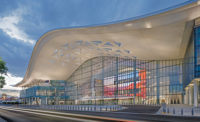While the Las Vegas Strip is best known for its extravagant productions, a highway construction project a few miles away in the northwest valley is stealing the spotlight. The Nevada Dept. of Transportation (NDOT) broke ground in January on the $155-million third and final phase of the Centennial Bowl, where U.S. Highway 95 meets the 215 beltway. The final act of the $300-million project will build out the remaining three ramps to finish the system-to-system interchange that first began work in 2015.
Funded by a combination of state, federal and county monies, the Centennial Bowl is projected to create nearly 1,700 direct, indirect and induced local jobs and is providing much needed economic stimulation amid a crippling pandemic, according to NDOT. When complete in early 2024, it will be one of the state’s largest interchanges, with 20 total bridges over three decks.
“This interchange connection will greatly enhance traffic mobility and motorist safety while establishing a new gateway for the Centennial area,” says NDOT spokesman Tony Illia. “Currently, nearly 110,000 vehicles daily travel the ramps and freeways at U.S. 95 and the 215 beltway, and it’s only expected to grow in the future.”
Starring Role
General contractor Las Vegas Paving Corp. has reprised its role in making the interchange a reality for each of the three phases of the project, despite the work being competitively bid on a low-cost, most qualified basis. The Las Vegas-based heavy-highway builder broke ground in July 2015, building north and southbound U.S. 95 connection ramps for the eastbound and westbound beltway, respectively, while also adding a southbound collector distributor road. Crews also widened U.S. Highway 95 in both directions between Ann Road and the beltway while adding 8,200 lineal ft of storm drainage, plus signs, lights and landscaping.
“Continuity, familiarity and camaraderie created a working shorthand, an easy back-and-forth between owner and contractor, which is something that only occurs over time,” Illia says. “Mutual trust and respect helped fast-track progress with clear communication and job expectations. And it enabled the team to hurdle past early site challenges, including staging, storage, traffic management and material deliveries.”
New direct freeway-to-freeway connections enable higher travel speeds for greater efficiency and safety that also forgoes the current stop-and-go surface street navigation. Additionally, project improvements provide a higher degree of local connectivity, including the addition of a multiuse recreational trail on the north side of the 215 beltway as well as several miles of new bike lanes and sidewalks, among other upgrades.
The new interchange made its debut in August 2017 with the completion of a $47-million, half-mile-long flyover that crosses two major freeways, linking westbound 215 to southbound U.S. Highway 95. The 60-ft-tall, 2,500-ft-long cast-in-place bridge, the equivalent of nearly seven football fields laid end to end, took more than 5.2 million lb of concrete to complete. It was crafted in three separate segments, each measuring roughly 860 ft and ranging from 1.68 million lb to nearly 1.83 million lb.
“This project helps create a reliable transportation network, enhancing cultural and economic opportunities in the northwest Las Vegas valley,” says Nevada Gov. Steve Sisolak, who also chairs the state transportation board. “It also improves accessibility, mobility and safety for residents and businesses.”
Gaining Traction
The interchange project hit its stride with the Centennial Bowl’s $73-million second phase, which broke ground in January 2019.
The project removed part of the Oso Blanca Road ramp and an old north-to-west loop, clearing right-of-way space within the gores for three new flyover ramp connections, including eastbound 215 beltway to U.S. Highway 95 southbound as well as southbound U.S. Highway 95 to eastbound 215 beltway and northbound U.S. Highway 95 to 215 beltway westbound.
The south-to-east flyover is 1,655 ft long, or roughly the same distance as the Sears Tower laid on its side. Meanwhile, the new 290-ft-long, 30-ft-tall east-to-south connector replaces the previous U.S. Highway 95 southbound access from a signalized interchange at the Oso Blanca Road-215 beltway. The connector crisscrosses the northwest flyover in midair, with both structures sitting atop a foundation of 60 drilled piles up to 80 ft deep and 10 ft in diameter.
Notably, the project also entailed building a 75-ft-tall by 39-ft-wide northwest flyover that measures 2,635 ft long (or seven football fields laid end to end), making it the state’s second-longest bridge. (Nevada’s longest bridge is the 1.6-mile-long Interstate 515 viaduct between Interstate 15 and Eastern Avenue in downtown Las Vegas.) The two-lane flyover is a box-girder structure constructed from cast-in-place, post-tensioned concrete.
The 13-span northwest bridge is connected by four frames and reinforced with 3 million lb of steel rebar, or enough iron to build 45 Sherman tanks. And it took 14,300 cu yd of concrete delivered by 1,500 cement mixer truck trips to complete. Other project improvements entail drainage upgrades and new lighting, landscaping and intelligent traffic system enhancements that the project finished piecemeal throughout late 2020.
“Most of the major work [in the second phase] was completed before the pandemic hit,” says Las Vegas Paving project manager Darren Keser. “We had our share of crews taking time off [with the coronavirus], but we got lucky. Because we were so far along, the bulk of the work was done, and we spent most of last year on roadwork tying everything in.”
The Grand Finale
The third and final phase, which launched in January, is the interchange’s biggest and most ambitious construction undertaking yet, consisting of 16 bridges. Las Vegas Paving will construct three flyovers: southbound U.S. Highway 95 to the westbound 215 beltway; the westbound 215 beltway to northbound U.S. Highway 95; and the eastbound 215 beltway to northbound U.S. Highway 95.
Additionally, the northbound U.S. Highway 95 to eastbound 215 beltway ramp will be widened to two lanes; a half-mile section of the 215 beltway will be expanded to a six-lane divided asphalt freeway; and a new service interchange at the 215 beltway and Sky Pointe Drive will be constructed with one-way slip ramps to and from Oso Blanca Road.
The project also will relocate and widen Sky Pointe Drive, connecting it from West Centennial Parkway to Azure Drive. Meanwhile, Oso Blanca will be realigned, linking it with Centennial Center Boulevard, and Lone Mountain Road will be widened between Tenaya Way and Rancho Drive.
“It’s a massive interchange between two freeways, with 20 bridges, and as an engineer, it’s just an awesome deal to construct,” says Abid Sulahria, assistant district engineer for NDOT. Coordinating the design has been the biggest challenge, having to meet the needs of so many agencies and stakeholders. “Any small thing can delay the project,” he adds, noting that the final phase entails more than 1,600 plan sheets.
“We’ve been out there with the same crews since 2012,” Keser adds, fluctuating between 1,200 to 2,000 workers moving from job to job. “Our biggest challenge right now is the public—both traffic and pedestrian—because of the spread out nature of the project. We’ve been dealing with traffic everywhere we turn, and with pandemic restrictions lifting, we’re back to an increase [in the public activity].”
The contractor is addressing this surge by designing and submitting traffic plans for approval to NDOT, setting out cones, barrels, signage and overhead height protection systems—“more than a normal project because we’re touching so many streets and keeping everyone where they need to be,” Keser says.
Project participants say the time and cost invested into the Centennial Bowl will be well worth it. Though challenging to design, the project will make a tremendous difference for the traveling public, Sulahria says.
“It has been an opportunity of a lifetime to work at one location with that amount of civil work. From an engineering standpoint, we’re leaving a legacy behind.”









